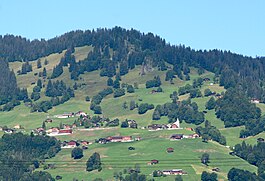Furna
Furna | |
|---|---|
 | |
| Coordinates: 46°56′N 9°40′E / 46.933°N 9.667°E | |
| Country | Switzerland |
| Canton | Graubünden |
| District | Prättigau/Davos |
| Area | |
| • Total | 33.32 km2 (12.86 sq mi) |
| Elevation | 1,400 m (4,600 ft) |
| Population (31 December 2018)[2] | |
| • Total | 221 |
| • Density | 6.6/km2 (17/sq mi) |
| Time zone | UTC+01:00 (Central European Time) |
| • Summer (DST) | UTC+02:00 (Central European Summer Time) |
| Postal code(s) | 7232 |
| SFOS number | 3862 |
| ISO 3166 code | CH-GR |
| Surrounded by | Grüsch, Jenaz, Peist, St. Peter-Pagig, Schiers, Trimmis, Valzeina |
| Website | www SFSO statistics |
Furna (Highest Alemannic: Furnä) is a Swiss village in the Prättigau and a municipality in the political district Prättigau/Davos Region in the canton of Graubünden.
History
[edit]Furna is first mentioned in 1479 as Furnen.[3]
Demographics
[edit]Furna has a population (as of 31 December 2020) of 207.[4] As of 2008[update], 0.5% of the population was made up of foreign nationals.[5] Over the last 10 years the population has grown at a rate of 0.5%. Most of the population (as of 2000[update]) speaks German (99.5%), with the rest speaking Norwegian ( 0.5%).[6]
As of 2000[update], the gender distribution of the population was 49.3% male and 50.7% female.[7] The age distribution, as of 2000[update], in Furna is; 34 children or 16.7% of the population are between 0 and 9 years old and 17 teenagers or 8.3% are between 10 and 19. Of the adult population, 24 people or 11.8% of the population are between 20 and 29 years old. 27 people or 13.2% are between 30 and 39, 24 people or 11.8% are between 40 and 49, and 22 people or 10.8% are between 50 and 59. The senior population distribution is 24 people or 11.8% of the population are between 60 and 69 years old, 26 people or 12.7% are between 70 and 79, there are 6 people or 2.9% who are between 80 and 89.[5]
In the 2007 federal election the most popular party was the SVP which received 49.8% of the vote. The next three most popular parties were the FDP (23%), the local, small right-wing parties (13.8%) and the SP (13%).[6]
The entire Swiss population is generally well educated. In Furna about 60.8% of the population (between age 25-64) have completed either non-mandatory upper secondary education or additional higher education (either university or a Fachhochschule).[6]
Furna has an unemployment rate of 0%. As of 2005[update], there were 52 people employed in the primary economic sector and about 21 businesses involved in this sector. 4 people are employed in the secondary sector and there are 3 businesses in this sector. 17 people are employed in the tertiary sector, with 7 businesses in this sector.[6]
The historical population is given in the following table:[3]
| year | population |
|---|---|
| 1850 | 216 |
| 1900 | 209 |
| 1950 | 222 |
| 2000 | 204 |
Geography
[edit]Furna has an area, as of 2006[update], of 33.3 km2 (12.9 sq mi). Of this area, 51.5% is used for agricultural purposes, while 38.3% is forested. Of the rest of the land, 1.3% is settled (buildings or roads) and the remainder (9%) is non-productive (rivers, glaciers or mountains).[6]
Before 2017, the municipality was located in the Jenaz sub-district of the Prättigau/Davos district, after 2017 it was part of the Prättigau/Davos Region.[8] It is a scattered settlement high above the valley. It consists of the village of Furna which is divided into Hinter-, Mittel- and Usserberg, as well as the seasonally occupied settlement of Furnerberg.
References
[edit]- ^ a b "Arealstatistik Standard - Gemeinden nach 4 Hauptbereichen". Federal Statistical Office. Retrieved 13 January 2019.
- ^ "Ständige Wohnbevölkerung nach Staatsangehörigkeitskategorie Geschlecht und Gemeinde; Provisorische Jahresergebnisse; 2018". Federal Statistical Office. 9 April 2019. Retrieved 11 April 2019.
- ^ a b Furna in German, French and Italian in the online Historical Dictionary of Switzerland.
- ^ "Ständige und nichtständige Wohnbevölkerung nach institutionellen Gliederungen, Geburtsort und Staatsangehörigkeit". bfs.admin.ch (in German). Swiss Federal Statistical Office - STAT-TAB. 31 December 2020. Retrieved 21 September 2021.
- ^ a b Graubunden Population Statistics Archived August 27, 2009, at the Wayback Machine (in German) accessed 21 September 2009
- ^ a b c d e Swiss Federal Statistical Office Archived January 5, 2016, at the Wayback Machine accessed 28-Oct-2009
- ^ Graubunden in Numbers Archived September 24, 2009, at the Wayback Machine (in German) accessed 21 September 2009
- ^ Swiss Federal Statistical Office - Amtliches Gemeindeverzeichnis der Schweiz - Mutationsmeldungen 2016 accessed 16 February 2017
External links
[edit]- Official homepage (in German)
- Furna in German, French and Italian in the online Historical Dictionary of Switzerland.





